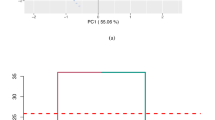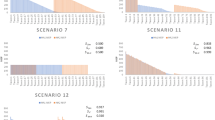Summary
Some characteristics of the more commonly used similarity coefficients have been discussed. Coefficients with undesirable properties include: the product moment correlation coefficient, some information statistics, the relative homogeneity function, the weighted similarity coefficient, the Euclidean (absolute) distance, Gleason's, Ellenberg's and Spatz's similarity indices, and the absolute value function.
Of the six coefficients that were tested with two sets of phytosociological data, the Canberra measure and the absolute Euclidean distance were the least successful, with at least one data set, in providing classifications that were similar to the classifications obtained by the Braun-Blanquet sorting technique. The standard Euclidean distance and the similarity ratio had intermediate success. The Czekanowski coefficient, especially in its relativized from (= relative absolute value function), was the most successful. This latter coefficient is cover-weighted and therefore the Canberra measure, although it has some undesirable characteristics, may be valuable for investigating relevé similarities that are based on species with low cover.
The transformation of Coetzee & Werger (1973) appears to be appropriate as a conversion of the cover-abundance values. The mean cover percent values corresponding to the cover-abundance values gave poor results.
The relativized Czekanowski coefficient should be suitable at the lower syntaxonomical levels. At higher levels, qualitative coefficients may be sufficient for determining similarities between syntaxa. Qualitative coefficients will not always be successful at the lower levels — this was illustrated with the test data.
In this study, the clustering procedure of group average sorting was used to construct the dendrogram. It gives an average similarity value within the dendrogram groups. These values can be used to give quantitative definitions to syntaxonomic rank.
Similar content being viewed by others
References
Campbell, B.M. & E.J., Moll. 1976. On numerical methods for classifying relevés collected in Braun-Blanquet phytosociological surveys. J. S. Afr. Bot. 42: 45–56.
Coetzee, B.J. & M.J.A., Werger. 1973. On hierarchical syndrome analysis and the Zurich-Montpellier table method. Bothalia 1: 159–164.
Czekanowski, J. 1909. Zur Differential-Diagnose der Neander-talgruppe. Korrespbl. Dt. Ges. Anthrop. 40: 44–47.
Dale, M.B. & D.J., Anderson. 1972. Qualitative and quantitative information analysis. J. Ecol. 60: 639–653.
Dale, M.J., G.N., Lance & L., Albrecht. 1971. Extensions of information analysis. Aust. Computer J. 3: 29–34.
Ellenberg, H. 1956. Aufgaben und Methoden der Vegetationskunde. E. Ulmer, Stuttgart. 136 pp.
Field, J.G. 1969. The use of the information statistic in the numerical classification of heterogenous systems. J. Ecol. 57: 565–569.
Frenkel, R.E. & C.M., Harrison. 1974. An assessment of the usefulness of phytosociological and numerical classification methods for the community biogeographer. J. Biogeogr. 1: 27–57.
Gleason, H.A. 1920. Some applications of the quadrat method. Bull. Torrey Bot. Club 47: 21–33.
Goodall, D.W. 1973a. Sample similarity and species correlation. In: R.H., Whittaker (ed.) Ordination and classification of of communities. Handbook of Vegetation Science, Part 5, pp. 105–156. Junk, The Hague.
Goodall, D.W. 1973b. Numerical methods of classification. In: R.H., Whittaker (ed.) Ordination and classification of communities. Handbook of Vegetation Science, Part 5, pp. 575–615. Junk, The Hague.
Hall, A.V. 1969. Avoiding information distortion in automatic grouping programs. Syst. Zool. 18: 318–329.
Hall, A.V. 1973. The use of a computer-based system of aids for classification. Contrib. Bolus Herb. 6: 1–56.
Janssen, J.G.M. 1972. Detection of some micropatterns of winter annuals in pioneer communities of dry sandy soils. Acta. Bot. Neerl. 21: 609–616.
Janssen, J.G.M. 1975. A simple clustering procedure for preliminary classification of very large sets of phytosociological relevés. Vegetatio 30: 67–71.
Jensén, S. 1978. Influences of transformation of cover on classification and ordination of lake vegetation. Vegetatio: 37: 19–31.
Kessel, R.S. & R.H., Whittaker. 1976. Comparison of three ordination techniques. Vegetatio 32: 21–29.
Lambert, J.M. & M.B., Dale. 1964. The use of statistics in phytosociology. Adv. Ecol. Res. 2: 59–99.
Lance, G.N. & W.T., Williams, 1967. A general theory of classificatory sorting strategies. I. Hierarchical systems. Comput. J. 9: 373–380.
Maarel, E. van der. 1972. On the transformation of coverabundance values in phytosociology, Report Botanical Laboratory Nijmegen, 12 pp.
Maarel, E. van der. 1978. Transformation of cover-abundance values in phytosociology and its effects on community similarity. Vegetatio (in press).
Moore, J.J., P., Fitzsimons, E., Lambe & J., White. 1970. A comparison and evaluation of some phytosociological techniques. Vegetatio 20: 1–20.
Mueller-Dombois, D. & H., Ellenberg. 1974. Aims and Methods of Vegetation Ecology. Wiley and Sons, New York. 557 pp.
Orlóci, L. 1966. Geometric models in ecology. I. The theory and application of some ordination methods. J. Ecol. 54: 193–215.
Orlóci, L. 1967. An agglomerative method to classify plant communities. J. Ecol. 55: 193–206.
Orlóci, L. 1968. Information analysis in phytosociology: partition, classification and prediction. J. Theor. Biol. 20: 271–284.
Orlóci, L. 1974a. On information flow in ordination. Vegetatio 29: 11–16.
Orlóci, L. 1974b. Revisions for the Bray and Curtis ordination. Can. J. Bot. 52: 1773–1776.
Orlóci, L. 1975. Multivariate analysis in vegetation research. Junk, The Hague. 276 pp.
Poldini, L. & E., Feoli. 1976. Phytogeography and syntaxonomy of the Caricetum firmae S. L. in the Carnic Alps. Vegetatio 32: 1–9.
Pritchard, N.M. & A.J.B., Anderson. 1971. Observations on the use of cluster analysis in botany with an ecological example. J. Ecol. 59: 727–747.
Smartt, P.F.M., S.E., Meacock & J.M., Lambert. 1976. Investigations into the properties of quantitative vegetational data. II. Further data type comparisons. J. Ecol. 64: 47–78.
Stephenson, W. & W.T., Williams. 1971. A study of the benthos of soft bottoms, Sek harbour, New Guinea, using numerical analysis. Aust. J. Mar. Freshwat. Res. 22: 11–34.
Stephenson, W., W.T., Williams & S.D., Cook. 1972. Computer analysis of Peterson's original data on bottom communities. Ecol. Monog. 42: 387–415.
Webb, L.J., J.G., Tracey, W.T., Williams & G.N., Lance. 1967. Studies in the numerical analysis of complex rain forest communities. II. The problem of species sampling. J. Ecol. 55: 525–538.
Webb, L.J., J.G., Tracey, W.T., Williams & G.N., Lance. 1970. Studies in the numerical analysis of complex rain forest communities. V. A comparison of the properties of floristic and physiognomic-structural data. J. Ecol. 58: 203–232.
Werger, M.J.A. 1974. The place of the Zurich-Montpellier method in vegetation science. Folia. Geobot. Phytotax. Praha. 9: 99–109.
Werger, M.J.A., F.J., Kruger & H.C., Taylor. 1972. A phytosociological study of the Cape Fynbos and other vegetation at Jonkershoek, Stellenbosch. Bothalia 10: 599–614.
Westhoff, V. & E.van der, Maarel. 1973. The Braun-Blanquet approach. In: R.H., Whittaker (ed.) Ordination and classification of communities. Handbook of Vegetation Science, Part 5, pp. 617–725. Junk, The Hague.
Whittaker, R.H. & H.G., GauchJr. 1973. Evaluation of ordination techniques. In: R.H., Whittaker (ed.). Ordination and classification of communities. Handbook of Vegetation Science, Part 5, pp. 289–321. Junk, The Hague.
Williams, W.T., H.T., Clifford & G.N., Lance. 1971. Group-size dependence: a rationale for choice between numerical classifications. Comput. J. 14: 157–162.
Williams, W.T. & M.B., Dale. 1965. Fundamental problems in numerical taxonomy. Adv. Bot. Res. 2: 35–68.
Williams, W.T., J.M., Lambert & G.N., Lance. 1966. Multivariate methods in plant ecology. V. Similarity analyses and information analysis. J. Ecol. 54: 427–446.
Williams, W.T., G.N., Lance, L.J., Webb & J.G., Tracey, 1973. Studies in the numerical analysis of complex rain forest communities. VI. Models for the classification of quantitative data. J. Ecol. 61: 47–70.
Woodwell, G.M. 1967. Radiation and the patterns of nature. Science 156: 461–470.
Author information
Authors and Affiliations
Additional information
This research was supported by the University of Minnesota. A grant from the UM Computer Centre is acknowledged. I am grateful to Prof. E. Cushing, Dr. E. van der Maarel, and Prof. L. Orlóci for criticism which has improved the paper.
Rights and permissions
About this article
Cite this article
Campbell, B.M. Similarity coefficients for classifying relevés. Vegetatio 37, 101–109 (1978). https://doi.org/10.1007/BF00126833
Accepted:
Issue Date:
DOI: https://doi.org/10.1007/BF00126833




